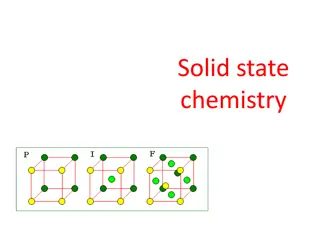
Microstructural Evolution in Materials: Solid Solutions Insights
Explore the fascinating world of microstructural evolution in materials, focusing on solid solutions and the indistinguishability of atoms. Understand Gibbs' theorem, ideal solid solutions, and the entropy of mixing for ideal gases. Dive into the theories behind regular binary solutions, inter-atomic forces, and random mixing preferences.
Download Presentation

Please find below an Image/Link to download the presentation.
The content on the website is provided AS IS for your information and personal use only. It may not be sold, licensed, or shared on other websites without obtaining consent from the author. If you encounter any issues during the download, it is possible that the publisher has removed the file from their server.
You are allowed to download the files provided on this website for personal or commercial use, subject to the condition that they are used lawfully. All files are the property of their respective owners.
The content on the website is provided AS IS for your information and personal use only. It may not be sold, licensed, or shared on other websites without obtaining consent from the author.
E N D
Presentation Transcript
MIT 3.022 Microstructural Evolution in Materials 2: Solid Solutions Juejun (JJ) Hu hujuejun@mit.edu
Solid solution consisting of indistinguishable atoms 1 In classical mechanics, all particles are distinguishable In quantum mechanics, two microscopic particles become indistinguishable if: 2 The particles are identical The wave functions of the particles spatially overlap Distinguishability does not affect energy but changes entropy 1 + 2
Selena & Eos Hu Number of states from permutation: = 2!
Gibbs theorem 1 Solid 1 consisting of n1 atoms on n1 lattice sites 1 = 1 S k = = ln 0 1 1 2 Solid 2 consisting of n2 atoms on n2 lattice sites 1 = 2 S k = = ln 0 2 2 Solid solution with the same lattice structure and completely random distribution of atoms 1 + 2 Inter-atomic force are the same for all three types of atomic pairs: 1-1, 2-2, and 1-2
Gibbs theorem 1 Ideal (random) solid solution ! ! ! n n n = + = n n n 1 2 1 2 2 ! n = = ln ln S k k ! ! n n n 1 2 n ( nk x ) = = ln ln + ln k n n n n 1 1 2 2 ( ) ln ln x x x 1 1 2 2 1 + 2 Entropy of mixing = ln S NR x x mix i i i N = x = = N 1 V V i i i i i i
Ideal solid solutions Inter-atomic force is the same for all types of bonds = ln S NR x x mix i i i = 0 H mix = ln G NRT x x mix i i i Random mixing is always preferred!
Gibbs theorem for ideal gas Entropy of mixing ideal gases (at the same T and P): i i i = ln S NR x x mix i i T, P, n2 T, P, n1 i = x = = V V 1 N N i i i Derivation: # of spatial sites m >> # of molecules n for ideal gas (classical limit of quantum statistics) ! ! ! n m n ( ) ( ) ( ) 1 2 1 2 1 2 ! n n m m n n + + ( ) ( 1 2 1 2 S S S S k n n = = + m ( ) ( ) = k m = 1 ln ln ln S m n n m n m n ( ) 1 1 1 1 1 1 1 1 1 1 1 1 1 + ! m m m n m n = = 1 2 1 2 Same T and P : ! 1 2 ) + ln ln x x x x 1 1 2 2
Regular binary solution theory Assumptions: 1 2 Random distribution of atoms ( ) ( ) 1,2 ij i P P = ( ) 2 Site i Site j 1 P j Bond energy between 1-2 is different from those of 1-1 and 2-2 ( ) = + = w x x ln ln S NR x x x x H 1 1 2 2 mix 1 2 mix ( ) = w x x + + ln ln G NRT x x x x 1 2 1 1 2 2 mix w negative enthalpy of mixing: 1-2 type of hetero- polar bond energetically favorable positive enthalpy of mixing: 1-1 and 2-2 types of homopolar bonds preferred 0 w 0
Negative enthalpy of mixing = w x x 0 H 1 2 mix ( ) = + ln ln S NR x x x x 1 1 2 2 mix = w x x T S G 1 2 mix mix
Positive enthalpy of mixing (high T) = w x x 0 H 1 2 mix ( ) = + ln ln S NR x x x x 1 1 2 2 mix = w x x T S G 1 2 mix mix
Positive enthalpy of mixing (intermediate T) = w x x 0 H 1 2 mix ( ) = + ln ln S NR x x x x 1 1 2 2 mix = w x x T S G 1 2 mix mix
Positive enthalpy of mixing (low T) = w x x 0 H 1 2 mix ( ) = + ln ln S NR x x x x 1 1 2 2 mix = w x x T S G 1 2 mix mix
Phase composition determination The composition of phases are determined by the common tangent lines on the Gibbs free energy curve Gmixat T = T0 Minimization of G = = = = 2 1 1, 1, 1 x1, x1, 2, 2, 2 The curve is generally asymmetric for real solutions
1 T Miscibility gap 2 T Miscible region 3 T 4 T T T T T 1 2 3 4 Convex G curve: miscible solution Concave G curve: phase separation
Summary Distinguishability of microscopic particles Gibbs theorem = = when ln S NR x x V V mix i i i i i = Ideal solid solution ln G NRT x x mix i i i Regular binary solution Negative enthalpy of mixing: single phase solution Positive enthalpy of mixing High temperature: single phase solution Low temperature: miscibility gap
List of symbols S entropy k Boltzmann constant (1.38 10-23m2kg s-2K-1) Number of microscopic states n number of atoms in solid solution N mole number of component in solid solution R Ideal gas constant (8.314 J mol-1 K-1) V Volume x Molar fraction of component Smix / Hmix / Gmix Entropy / enthalpy / Gibbs free energy of mixing
List of symbols T Temperature Pi Probability of atom site i being occupied by atom 1 w A constant proportional to enthalpy of mixing: w < 0 corresponds to negative enthalpy of mixing, and w > 0 indicates positive enthalpy of mixing 1, Chemical potential of component 1 in phase






















